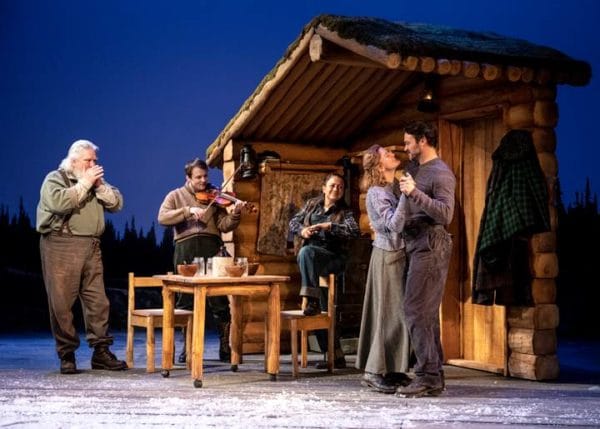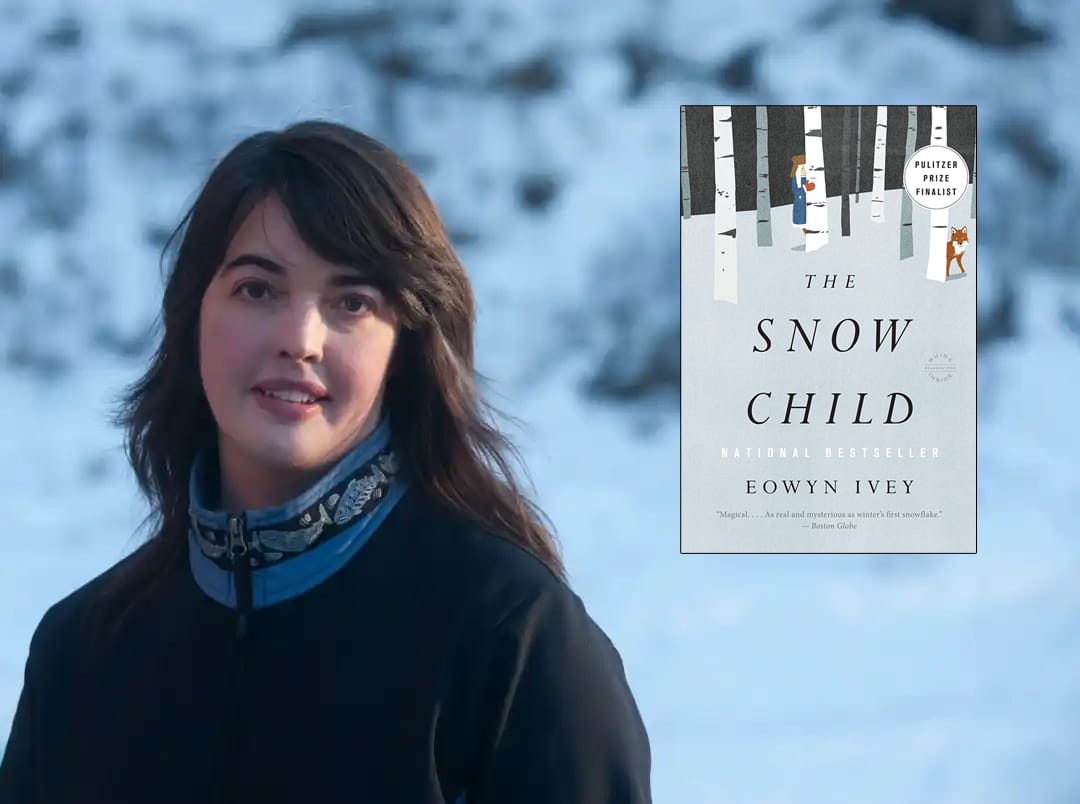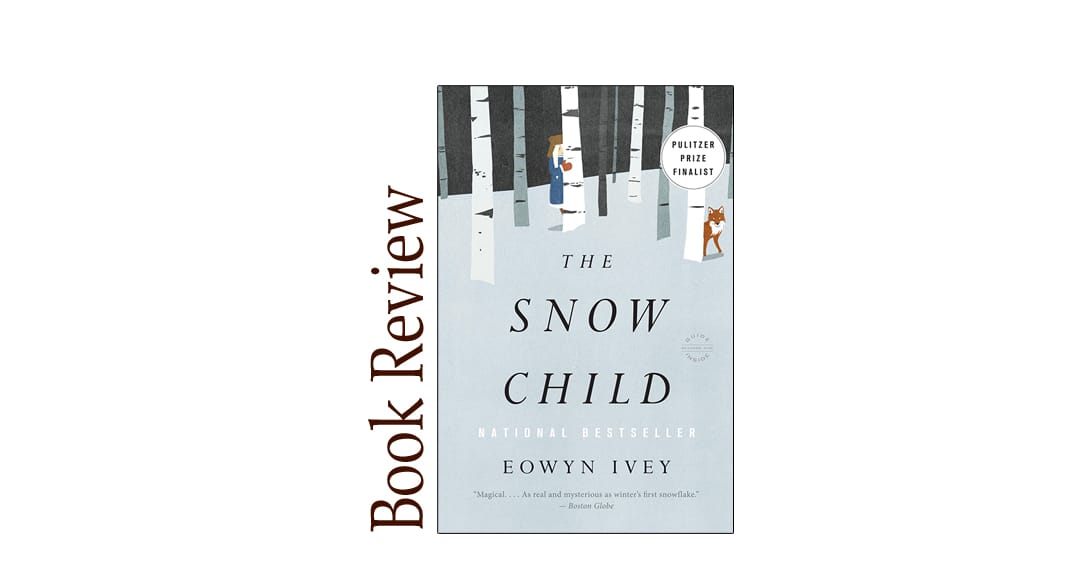- Date Published:
2012 - Length:
400 pages—Listening Time: 10 hr 57 minutes - Genre:
Fiction, Historical Fiction, Fantasy - Setting:
1920s, Alaska wilderness - Awards:
International Dublin Literary Award Longlist 2014; Pulitzer Prize Finalist Fiction 2013; Indies Choice Book Awards Winner Adult Debut 2013; Pacific Northwest Booksellers Association Award Winner 2013; British Book Awards Winner International Author 2012; Tähtifantasia Award Nominee 2014; Center for Fiction First Novel Prize Shortlist 2012; Barnes & Noble Discover Prize Finalist Fiction 2012; Waterstones 11 2012; Rochester Reads 2014; Goodreads Choice Awards Nominee Historical Fiction 2012 - Languages:
Danish, Dutch, English, Finnish, French, German, Hungarian, Italian, Latin, Lithuanian, Norwegian, Polish, Portuguese, Romanian, Slovak, Spanish, Swedish - Sensitive Aspects:
Animal cruelty, animal death, child death, miscarriage, infertility, depression, loneliness, stillbirth, suicidal thoughts, attempted suicide, graphic hunting and violence, death, body horror, medical trauma, grief, abandonment, alcoholism, mental illness, sexism, toxic relationships, isolation, mild language, mild substance use, implied sexual content, and mild childbirth description - Movie:
Eowyn Ivey's novel The Snow Child has not been adapted into a feature film, and there are no current movie deals publicly announced. However, there have been other adaptations of the story, most notably a stage musical and an opera. - Recommended for Book Club:
Yes

Get ready to shiver, as in brrrrr cold. Some books hit like a gut punch. Others feel like homework in disguise. And then, every once in a while, you stumble across a story that doesn’t demand anything from you but rather quietly invites you in, handing you a blanket, and saying, “Sit. Breathe. Let’s remember what wonder feels like.”
That’s what The Snow Child by Eowyn Ivey did for my very overworked, emotionally overloaded reading brain.
If your recent reads have been on the “heavy” side—war epics, generational trauma, relentless bleakness with a side of despair—this novel is the perfect palate cleanser. Not because it’s shallow (it isn’t), but because it moves at the gentle pace of snowfall, with that same hush-your-soul quality. It’s the kind of book that makes you exhale in the best way, like finally loosening a too-tight scarf.
Ideally, you’d read The Snow Child while snuggled under a fleecy blanket, favorite mug of something hot and steaming in hand, as wind rattles the windows and you feel very smug about not being outside. But honestly? It might be even better as a beach read. There’s something deliciously perverse about sitting under a blazing sun, toes in the sand, reading about blizzards, frozen rivers, and snowshoe tracks disappearing into the trees. Instant internal air-conditioning.
Set in 1920s Alaska, the book drops you into a landscape that was still more wilderness than anything resembling comfort. At the time, Alaska was a U.S. territory, not yet a state, with a total population roughly the size of a small city today. Many homesteaders lived days from their nearest neighbor. Travel often meant dog sled or riverboat, not hopping in the car; winter temperatures could plunge to -40 degrees and stay there, turning simple chores like fetching water into small expeditions.
Electricity and indoor plumbing were luxuries you might find in a few towns, but out on the land? You had an axe, a lantern, and your own stubbornness. Mail could take weeks to arrive. A bad storm could cut you off entirely. The line between survival and catastrophe was thin, and very, very cold.
Into that stark, rugged backdrop, Ivey threads a story that feels part fairy tale, part marriage study, and part meditation on grief and hope. It’s quiet but never dull, magical but grounded, and it lets you live—just for a while—at the edge of a snowy river in a world where a child made of snow might actually come to life.
And if your reading life needs a soft reset, this is a pretty enchanting place to start.

It’s 1920s Alaska, and Mabel and Jack have done something most people only threaten to do when life gets hard: they’ve actually packed up, left everything behind, and moved to the edge of the known world. Middle-aged, childless, and carrying a grief that doesn’t quite have words, they arrive in the raw, brutal Alaskan wilderness hoping to start over. Instead, they find bitter cold, backbreaking labor, and a silence that can feel like it’s pressing on your ribs.
One night, in the middle of the season when the snow never seems to end, something almost playful breaks through the gloom. After a rare bout of laughter, Mabel and Jack build a child out of snow—a little snow girl with a scarf and mittens, like something out of a fairy tale. By morning, the snow child is gone.
But then they start seeing her.
At the tree line, a small figure darts between the birches. Fox tracks appear around their homestead. A little girl, wild and shy, wearing the same scarf and mittens, begins to visit. She calls herself Faina. She knows the woods like an animal does, comes and goes with the snow, and seems to belong more to the winter than to any human world. Is she a real child, abandoned and surviving against all odds? Or something else—something the forest itself has loaned them?


Snow Child (the musical) ran April 13-May 20, 2018, at Arena Stage at the Mead Center for American Theater. Photo by Maria Baranova.
As the seasons turn, Mabel and Jack’s relationship with Faina deepens and complicates. They begin to love her with the fierce, terrified love of parents who know how easily the world can take things away. The neighbors, the Benson family, bring warmth, chatter, and a more practical frontier energy into the story, grounding the couple’s fragile joy in the ordinary rhythms of homestead life. Still, the mystery of Faina never quite settles. She thrives in the snow and fades in the warmth. She appears after storms. She disappears without warning. Every answer they think they’ve found only opens up another question.
The novel walks a tightrope between realism and myth. On one page, you’re in the grit of frontier survival—bloodied hands, frozen crops, moose in the garden. On the next, you’re wondering if you’ve slipped into a fairy tale where the rules of nature and grief bend just a little. As Faina grows and the years pass, the stakes rise. What does it mean to love someone who can’t be held onto? And what happens when the seasons change, as they always do?
The Snow Child doesn’t shout its story; it hums it, like a song half-remembered from childhood—unsettling, tender, and impossible to shake once you’ve heard it.

The Snow Child is quiet, emotional, a little bit magical, and sneakily powerful—perfect for readers who like their stories slow-burning but deeply felt.
Here’s why the Readers with Wrinkles crowd will devour this book.
It’s about starting over… when you’re not 25
Jack and Mabel aren’t shiny young newlyweds; they’re older, worn down, and trying to rebuild a life that hasn’t gone the way they planned. Watching them start fresh in Alaska hits very differently when you’ve already lived through a few “reinvention” chapters yourself.
A raw, honest look at a long marriage
This isn’t a rom-com marriage where a quirky fight is fixed in three pages. Jack and Mabel deal with silence, resentment, tenderness, and tiny acts of care that feel painfully real, especially if you’ve ever had the same argument for ten years.
Grief and childlessness handled with real emotional depth
The novel leans into grief without turning it into melodrama. If you’ve ever lost a dream—whether it was a child, a relationship, or a life you imagined—you’ll recognize the quiet ache sitting between these characters.
The magical realism is subtle, not gimmicky
Is the snow girl real? Is she imagined? The book never whacks you over the head with an explanation, which makes the story feel like an old folktale told around the fire. Readers who don’t like overt fantasy will still feel right at home here.
Nature writing that makes you feel the cold in your bones
Ivey’s Alaska isn’t just a backdrop; it’s a character with teeth. You’ll practically feel the sting of snow on your face and the creak of trees outside your window—without needing to shovel a single driveway.
The pacing is calm, not chaotic
This isn’t a book that sprints; it strolls, pauses, and lets you breathe. For readers who are tired of twist-every-three-pages thrillers, the gentler rhythm feels like a relief, not a flaw.
Perfect for readers who grew up on fairy tales
If you loved fairy tales as a child but now need your stories with complicated emotions and moral ambiguity, this is that sweet spot. It feels both familiar and grown-up, like a folktale that’s lived a full life.
Strong, complex older female characters
Mabel isn’t just “the wife,” and her neighbor Esther is one of those rugged, practical women you instantly want in your corner. The women in this story are textured, flawed, capable, and often the emotional backbone of the narrative.
It sparks great book club conversations
Is Faina real or symbolic? Did Jack and Mabel make the right choices? What would you have done in that kind of isolation? This is one of those books where your opinion might change as you talk about it—and that’s gold for discussion.
It respects quiet readers and quiet lives
There are no billionaires, secret spies, or Instagram influencers here—just farmers, neighbors, and people trying to survive winter and each other. If you’ve ever felt that your own life is “too ordinary” for fiction, this book says, respectfully, absolutely not.
It captures the beauty and terror of solitude
The novel understands the difference between being alone and being lonely. For anyone who’s lived in a quiet house, an empty nest, or a new town, the emotional landscape of that isolation will feel very familiar.
It lingers after you close the book
You may not remember every plot point, but you’ll remember how it felt: tender, bittersweet, and a little mysterious. It’s the kind of story that floats back into your mind weeks later while you’re making tea or watching it snow.


Purchase Eowyn Iveyl Books
Step into Eowyn Ivey’s luminous, Alaska-rooted novels, where the wild landscape shapes fragile human hearts and the ordinary world shimmers with the quiet possibility of magic.
Bookshop.org was created as a socially conscious alternative to Amazon, with the goal of helping local, independent bookstores thrive. This is why Readers With Wrinkles supports their efforts. Please join us in this effort by purchasing your next read here.

Here are twelve atmospheric, wintry, and gently magical novels that echo the isolation, folklore, and emotional depth of The Snow Child in different ways.
- To the Bright Edge of the World by Eowyn Ivey
Set once again in the Alaskan wilderness, this novel follows Colonel Allen Forrester’s perilous 1885 expedition up the fictional Wolverine River, told through journals, letters, photographs, and other archival fragments. As his pregnant wife Sophie remains behind at the Vancouver Barracks, both spouses confront isolation, danger, and the uncanny as Indigenous myths and inexplicable encounters blur the line between reality and legend. It lacks the direct fairy-tale frame of The Snow Child but offers a similarly lyrical, slow-burning mix of harsh frontier realism and subtle, haunting magic. - The Great Alone by Kristin Hannah
In the 1970s the Allbright family moves to remote Alaska, hoping the wild landscape will heal Ernt, a volatile Vietnam POW, but the brutal winters and his worsening instability turn their homestead into a place of danger. Through teenage daughter Leni’s eyes, the story explores domestic violence, survival, and first love against a backdrop of stunning yet unforgiving wilderness and long dark seasons. Readers who loved the way The Snow Child balances beauty and brutality in frontier life will find a similarly immersive Alaskan setting and emotional intensity here. - The Bear and the Nightingale by Katherine Arden
Set in medieval northern Russia, this novel draws deeply on Russian folklore and mythology, weaving an atmospheric winter tale where old household spirits and forest beings linger even as Christianity tightens its grip. Written in a lyrical, fairy-tale-like style, it follows a young woman’s coming-of-age amid blizzards, ancient magic, and patriarchal expectations in a snowbound village. The combination of bitter cold, family drama, and ambiguous enchantment makes it an excellent match for readers drawn to the folkloric undercurrent of The Snow Child. - Wolf Winter by Cecilia Ekbäck
This historical thriller takes place in 1717 Swedish Lapland, where a Finnish family moves to a remote settlement on Blackåsen Mountain and soon discovers a murdered man’s body on their new land. As Maija and her daughter Frederika probe the killing, a particularly harsh “wolf winter” descends, the isolated community turns inward, and hints of the supernatural mingle with grim realities of hunger, fear, and suspicion. The result is a gloomy yet riveting blend of cold-climate mystery, pastoral detail, and magic realism that mirrors the ominous, snowbound mood of Ivey’s Alaska. - Gingerbread by Robert Dinsdale
This novel follows an orphaned boy and his grandfather who travel into the forests of Belarus to scatter the boy’s mother’s ashes, a journey that forces the child to protect his fragile, secret-laden elder. In the woods, the grandfather’s folktales about Baba Yaga and old-country legends seep into their reality until memory, grief, and story become almost indistinguishable. Fairytale and history, wilderness and civilization collide in a haunting, melancholy way that will resonate with readers who appreciated the grown-up fairy-tale tone of The Snow Child. - Moon of the Crusted Snow by Waubgeshig Rice
In a remote Anishinaabe community in northern Ontario, the power goes out, phones die, and contact with the outside world vanishes just as winter closes in. As supplies dwindle and white outsiders arrive seeking refuge, tensions rise, forcing young Evan Whitesky and his neighbors to draw on community traditions and hard choices to survive the new darkness. The quiet pacing, snowbound isolation, and emphasis on Indigenous resilience give this post-apocalyptic story a grounded, eerie tone that pairs well with the existential chill and community focus of The Snow Child. - Winter’s Tale by Mark Helprin
This expansive novel imagines a magical version of New York where a middle-aged Irishman and a dying young woman fall in love, their story stretching across time and blurring the boundaries between realism and myth. The book is often described as a fabulous urban fairy tale, full of larger‑than‑life characters, miraculous events, and a strong sense of place that feels both nostalgic and otherworldly. Readers who enjoyed the sense that the natural world in The Snow Child is slightly enchanted may appreciate how Helprin treats the city itself as a wintry, enchanted landscape. - The Golem and the Jinni by Helene Wecker
Set in New York City around 1899 and the early 1900s, this novel follows two magical beings—a golem and a jinni—who find themselves living in human immigrant communities and trying to pass as ordinary people. The story is richly written and rooted in a believable historical setting, exploring themes of identity, belonging, and cultural collision while never losing sight of its quietly fantastical premise. Its blend of historical detail, wintry atmosphere, and low-key magic makes it a good fit for readers who liked the gentle, ambiguous supernatural elements in The Snow Child. - The House of the Spirits by Isabel Allende
This multigenerational family saga, often cited as a cornerstone of Latin American magical realism, follows several generations of the Trueba family from the early 20th century through the political upheavals of the 1970s. The narrative mixes love stories, class conflict, and tyranny with ghosts, prophetic visions, and other supernatural touches that feel woven into everyday life rather than set apart from it. If what resonated in The Snow Child was the subtle, matter‑of‑fact magic inside a very human story of love and loss, Allende’s sweeping, emotionally rich novel offers that in a more expansive, political key. - Snow Falling on Cedars by David Guterson
On a small island in Puget Sound in the 1950s, Japanese‑American fisherman Kabuo Miyamoto is tried for the murder of Carl Heine, a white war veteran, while a fierce snowstorm isolates the town. The trial narrative reveals a past interracial romance, the legacy of Japanese internment, and deep‑rooted racism, all unfolding under the hush and menace of heavy snowfall. Though not fantastical, its slow, atmospheric pacing and snow‑drenched setting will appeal to readers who loved the contemplative, wintry mood and moral complexity of The Snow Child. - Smilla’s Sense of Snow by Peter Høeg
This novel centers on Smilla Jaspersen, a half‑Inuit glaciologist living in Copenhagen who becomes convinced that the “accidental” rooftop death of her young neighbor Isaiah was actually murder. Her investigation pulls her from bureaucratic Danish streets onto an icebreaker headed toward a remote, glaciated island off Greenland, exposing corporate conspiracies, dangerous expeditions, and a chilling mystery bound up with snow and ice. The combination of an isolated polar landscape, a tough yet vulnerable outsider protagonist, and an almost uncanny sensitivity to snow makes this a strikingly wintry complement to Ivey’s book. - The Ocean at the End of the Lane by Neil Gaiman
An unnamed man returns to his childhood hometown for a funeral and finds himself drawn back to the Hempstock farm at the end of the lane, where memories of his friend Lettie and a series of strange events begin to resurface. As he recalls how a suicide opened the door for a malevolent entity and how the Hempstock women fought to protect him, the story becomes a dark fairy tale about childhood terror, sacrifice, and the blurring of memory and myth. Gaiman’s slim novel, often praised for its meditation on lost and recovered memories and its haunting, magical atmosphere, is a strong pick if you loved the bittersweet, uncanny tone of The Snow Child.


Comments